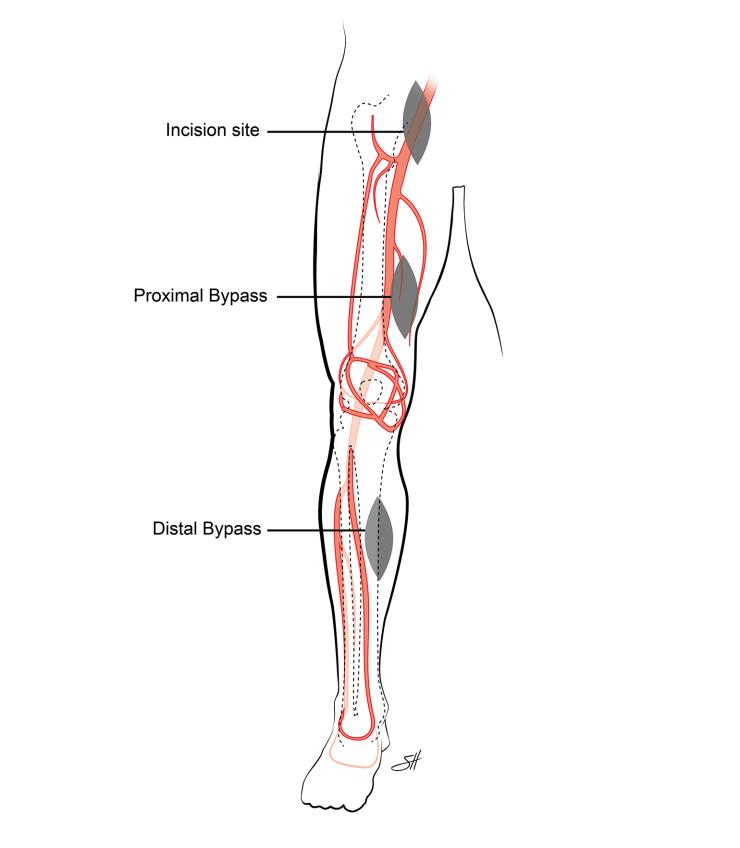What Is Bypass Surgery?
Bypass surgery is indicated for patients who are not good candidates for minimally invasive procedures, such as angioplasty and stenting. Open bypass operation for peripheral artery disease is a well-established surgery that can be very effective. This is a major surgical operation performed under anesthesia and involving incisions in the leg. With the assistance of a graft (natural or synthetic), a surgical bypass directs blood flow around an area of blockage caused by peripheral artery disease (PAD). The surgery does not cure the disease or remove the blockage.
Why Is Open Bypass Performed?
Symptoms of a blocked peripheral artery are pain, achiness, or heaviness in your leg that starts or gets worse when you walk.
You may not need open bypass surgery if these problems happen only when you walk and then go away when you rest. You may not need this surgery if you can still do most of your everyday activities. Your doctor can try medicines and other treatments first.
Your Surgery
At Baylor College of Medicine, our vascular surgery experts specialize in the treatment of peripheral artery disease. You and your team will discuss all of your surgical treatment options and come up with a plan that suits your individual condition.
You will have an anesthesiologist in charge of your anesthesia. Your anesthesiologist will see you before the operation and review with you the risks and approaches. You may have general anesthesia or, instead, an epidural or spinal anesthesia. You will be in a deep, painless sleep. Some patients may have local anesthesia to numb only the area being worked on. Be sure to ask the anesthesiologist any questions you may have.
Either an upper or lower leg bypass is from your femoral artery in your groin to one of your arteries just above or below the knee. Once the surgeon has access to the blocked section of the artery, the graft is sewn in place. The graft is a vein, usually from the leg being operated on, or is made of artificial material and is shaped like a tube. The graft bypasses (goes around) the obstructed arteries of the thigh and leg.
After Open Bypass Surgery
Right after surgery, you will go to the recovery room, where nurses will watch you closely. After that you will go either to the intensive care unit (ICU) or a regular hospital room.
You may need to spend one or two days in bed if the surgery involves the large artery in your abdomen called the aorta. Most people stay in the hospital for four to seven days. After femoral popliteal (thigh and upper leg) bypass, you will spend less time or no time in the ICU.
You will be encouraged to get out of bed and start walking quite early. You will slowly increase how far you can walk. You will find that walking will hasten your recovery and also lessen the likelihood of developing clots in the veins of your legs.
Your pulse will be checked regularly after your surgery. The strength of your pulse will show how well your new bypass graft is working. While you are in the hospital, tell your provider right away if the leg that had surgery feels cool, looks pale or pink, feels numb, or if you have any other new symptoms.
You will receive pain medicine if you need it. Pain from the operation steadily lessens over the subsequent few days so that by the time you leave the hospital you may not need pain medication or it can easily be controlled with over-the-counter medicine.
Your medical team will advise you on post-operative restrictions and schedule your follow-up visits to our clinic with you before you leave.
Outlook
Although it is a moderately big operation, the results of bypass surgery are generally good. The procedure improves blood flow in the arteries for most people. Two-thirds of these bypasses stay open for five years; relief of symptoms is usually excellent as long as the graft remains open.
You may experience no symptoms, even when walking. Even if you still have symptoms, you should be able to have more mobility.
Your symptoms may not improve as much if you have blockages in multiple arteries.








 Credit
Credit

